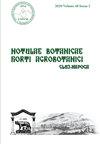Discrete nutrient utilizations in two Bauhinia species exposed to supplemental light-emitting diode spectra and exponential fertilization
IF 1.3
4区 生物学
Q3 PLANT SCIENCES
引用次数: 0
Abstract
Bauhinia is a widely planted urban tree plant in tropical cities, which are frequently dwelling in a habitat exposed to inevitable streetlamp lighting. It is of practical meaning to figure out the lighting spectra that benefit nutrient utilization in corporation with a proper exponential fertilization regime. In this study, Bauhinia brachycarpa and B. variegata seedlings were cultured with exponential fertilization at the rate of 80 mg nitrogen (N) plant-1 (N-phosphorus-potassium, 10-7-9) with an unfertilized control, and both were exposed to light-emitting diode spectra of R1BG5 (13.9% red, 77.0% green, 9.2% blue), R2BG3 (26.2% red, 70.2% green, 3.5% blue), and R3BG1 (42.3% red, 57.3% green, 0.4% blue). The R3BG1 spectrum resulted in smaller growing size and dry mass but higher nutrient concentration and root water content compared to the other two spectra. Exponential fertilization increased fresh mass for two Bauhinia species but only increased dry mass in B. brachycarpa. Compared to B. variegata, B. brachycarpa was verified to have a higher capacity to accommodate exogeneous nutrient input through exponential fertilization. The R3BG1 spectrum was recommended for the illumination in streetlamps for Bauhinia because this spectrum can promote nutrient uptake without too fast rate of growth relative to other spectra with lower red-light proportions.两种紫荆花暴露于补充发光二极管光谱和指数施肥的离散养分利用
紫荆花是热带城市中广泛种植的城市乔木植物,它们经常居住在路灯照明的栖息地。在适宜的指数施肥制度下,确定有利于养分利用的光照光谱具有实际意义。以短叶紫荆(Bauhinia brachycarpa)和斑叶紫荆(B. variegata)幼苗为对照,以80 mg氮肥(N-磷-钾,10-7-9)为指数施肥,在R1BG5(13.9%红,77.0%绿,9.2%蓝)、R2BG3(26.2%红,70.2%绿,3.5%蓝)和R3BG1(42.3%红,57.3%绿,0.4%蓝)的发光二极管光谱下进行培养。与其他两个光谱相比,R3BG1光谱的生长尺寸和干质量较小,但营养物质浓度和根含水量较高。指数施肥增加了两种紫荆花的新鲜质量,但只增加了短叶紫荆花的干质量。结果表明,与杂色小檗相比,短叶小檗通过指数施肥具有更高的适应外来养分输入的能力。R3BG1光谱可以促进紫荆花的营养吸收,相对于其他红光比例较低的光谱,其生长速度不会太快,因此推荐用于紫荆花路灯照明。
本文章由计算机程序翻译,如有差异,请以英文原文为准。
求助全文
约1分钟内获得全文
求助全文
来源期刊

Notulae Botanicae Horti Agrobotanici Cluj-napoca
PLANT SCIENCES-
CiteScore
2.70
自引率
0.00%
发文量
118
审稿时长
3 months
期刊介绍:
Notulae Botanicae Horti Agrobotanici Cluj-Napoca is a peer-reviewed biannual journal aimed at disseminating significant research and original papers, critical reviews and short reviews. The subjects refer on plant biodiversity, genetics and plant breeding, development of new methodologies that can be of interest to a wide audience of plant scientists in all areas of plant biology, agriculture, horticulture and forestry. The journal encourages authors to frame their research questions and discuss their results in terms of the major questions of plant sciences, thereby maximizing the impact and value of their research, and thus in favor of spreading their studies outcome. The papers must be of potential interest to a significant number of scientists and, if specific to a local situation, must be relevant to a wide body of knowledge in life sciences. Articles should make a significant contribution to the advancement of knowledge or toward a better understanding of existing biological and agricultural concepts. An international Editorial Board advises the journal. The total content of the journal may be used for educational, non-profit purposes without regard to copyright. The distribution of the material is encouraged with the condition that the authors and the source (Notulae Botanicae Horti Agrobotanici Cluj-Napoca or JCR abbrev. title Not Bot Horti Agrobo) are mentioned.
 求助内容:
求助内容: 应助结果提醒方式:
应助结果提醒方式:


